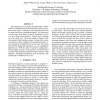682 search results - page 100 / 137 » Autonomous Environment and Task Adaptation for Robotic Agent... |
AAAI
2008
13 years 11 months ago
2008
Spatial scaffolding is a naturally occurring human teaching behavior, in which teachers use their bodies to spatially structure the learning environment to direct the attention of...
FPL
2009
Springer
14 years 1 months ago
2009
Springer
Self-organization is a natural concept that helps complex systems to adapt themselves autonomically to their environment. In this paper, we present a self-organizing framework for...
NIPS
1990
13 years 10 months ago
1990
We present a new connectionist planning method TML90 . By interaction with an unknown environment, a world model is progressively constructed using gradient descent. For deriving ...
CORR
2011
Springer
13 years 3 months ago
2011
Springer
Recent research in multi-robot exploration and mapping has focused on sampling environmental fields, which are typically modeled using the Gaussian process (GP). Existing informa...
HICSS
2007
IEEE
14 years 3 months ago
2007
IEEE
Systems using Software Agents (or Multi-Agent Systems, MAS) are becoming more popular within the development mainstream because, as the name suggests, an Agent aims to handle task...

